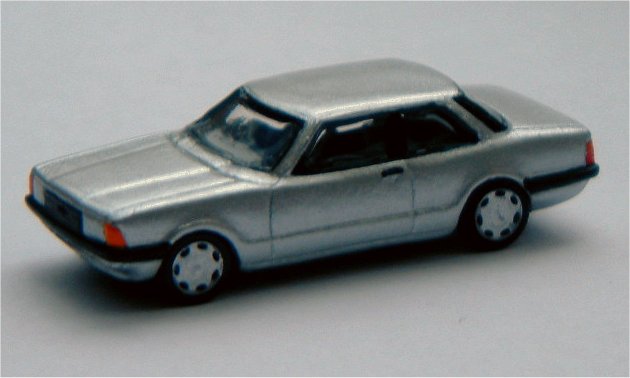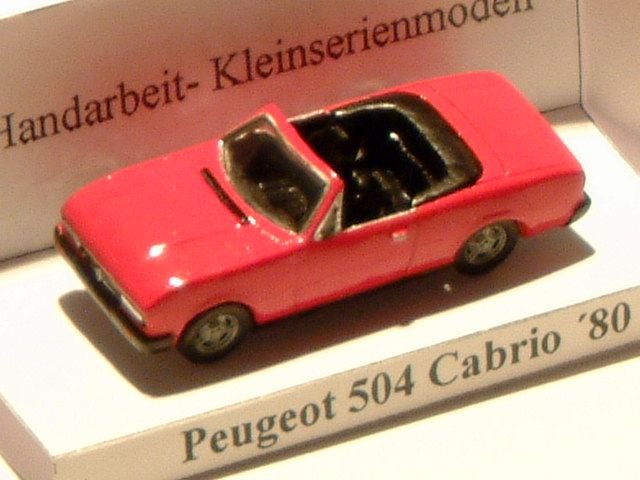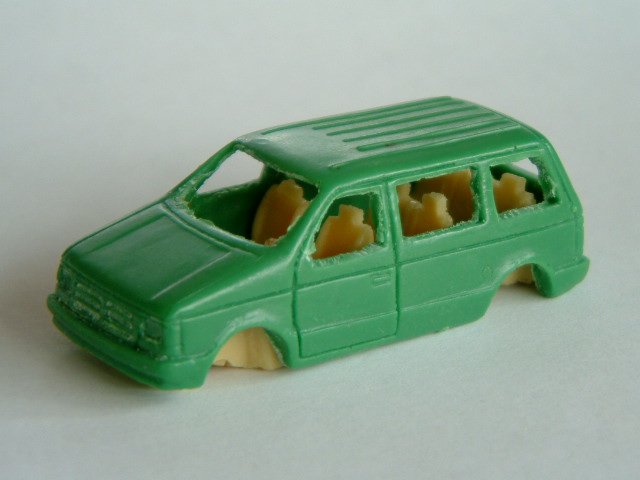On-line since 2002
> 600
pages
> 1150 manufacturers
> 11000
pictures
> 1.000.000 unique visitors
87thScale.info does not
spam. If you received a
spam message with an 87thScale return mail
address it is forged.
MFM - Martin Fredrich Modelle
Mr Fredrich started to offer his resin kits in 1996, among the first castings were the Peugeot 104, 205, 203 Convertible, Citroen CX and Chrysler Voyager. Over the years MFM has developed a wide range of prototypically correct kits which include body and interior (resin), glazing and Herpa wheels. Also available through MFM is a selection of modelkits made by Niedermeyer (VN).

Translation of July 2003 E-mail interview with Martin Fredrich
| Q: A mandatory question, how and why did you start building models from scratch? How is that related to your hobby? What do you do for a living? MF: I am working full-time as an interior decorator. My first experiences with modelcars come from the time when I was four years old. The neighbor boy, who was ten, used to display his Wiking models in the summer- house colony. When I was seven or eight I got my first own Wiking models and from then on collected continously. Of course, the very first models were heavily played with.
After some time I was more and more disappointed that so many cars (especially my own French ones) were not available as models, the more so since my interest changed from Wiking only to cars in general. My first kit was a BS Design Alfa Spider '90 which I built successfully. The second kit I tackled, a BS Design Opel Manta, then almost made me give up on it again. That model is still unfinished.
Getting info on small series manufacturers has always been difficult, but somehow I stumbled over the address of US Models and bought a few kits there. I managed to build them and some Le Mans Miniatures models as well. At that time I also intended to build a diorama of a Citroen repair shop (an unfinished project, too).
Then, I got Mr Haubrich's address, he responded to my inquires and I ordered some Focus models.
I converted the Focus kits of the Chrysler Voyager and Peugeot 309 to more useable models by cutting them into four pieces each. The Voyager was narrowed, the Peugeot was
broadened. Everything was smoothed and newly engraved. How successful these conversions were can still be seen in my program, although I made the models primarily for myself.
After so much reconstruction on the two models I thought I could possibly build a model from scratch, too, and so the Peugeot 104 came into being (that was my first car by the way, drove it for almost a year until it rusted away under my backside). |
The following MFM models are or have been available:
| Cat# | Model | Cat# | Model |
| 001 | Peugeot 104 GL '77 5 doors | 105 | Jeep Wrangler 4.0 '90 Hardtop |
| 002 | Peugeot 104 ZL 3 doors | 150 | Talbot Samba |
| 003 | Peugeot 205 '90 3 doors | 151 | Talbot Samba Convertible |
| 004 | Peugeot 205 GTI '90 | 152 | Simca 1000 '69 |
| 005 | Peugeot 205 CJ Convertible '90 | 153 | Simca 1000 Rallye 2 '76 |
| 006 | Peugeot 205 Multi Van | 200 | VW Polo '81 |
| 007 | Peugeot 203 Convertible '51 | 201 | VW Polo Coupé '82 |
| 008 | Peugeot 204 Convertible | 202 | VW Derby '82 |
| 009 | Peugeot 204 Coupé | 205 | VW Polo Sedan '85 |
| 010 | Peugeot 309 '90 3 doors | 206 | VW Jetta '84 |
| 011 | Peugeot 305 '82 | 300 | Nissan Primera '95 |
| 012 | Peugeot 305 Break '82 | 301 | Nissan Primera Hatchback '95 |
| 013 | Peugeot 504 Convertible '80 | 350 | Opel Rekord D |
| 014 | Peugeot 504 Coupé '80 | 351 | Opel Rekord D Caravan |
| 015 | Peugeot 604 | 352 | Opel Commodore B Coupé |
| 016 | Peugeot 405 MI 16 '93 | 353 | Opel Rekord D Coupé |
| 019 | Peugeot 405 Break | 354 | Opel Commodore B |
| 020 | Peugeot 405 '93 | 359 | Opel Rekord E2 Caravan |
| 021 | Peugeot 204 | 361 | Opel Kadett Combo |
| 022 | Peugeot 204 Break | 362 | Opel Kadett E Caravan |
| 023 | Peugeot 205 5 doors | 400 | Ford Scorpio |
| 024 | Peugeot 309 '90 5 doors | 401 | Ford Scorpio Turnier |
| 025 | Peugeot 403 '55 | 402 | Ford Scorpio Hatchback |
| 026 | Peugeot 403 Break '56 | 403 | Ford Scorpio Turnier '96 |
| 027 | Peugeot 403 Convertible '56 | 451 | Fiat Ducato Police long wheelbase |
| 028 | Peugeot 504 | 500 | Cadillac Convertible '66 |
| 029 | Peugeot 504 Break | 501 | Pontiac Trans Sport '94 |
| 030 | Peugeot 504 Pickup | 900 | Bugatti EB 110 |
| 035 | Peugeot 504 Convertible '78 | 901 | Ferrari 456 GT (never issued) |
| 037 | Peugeot 607 | 903 | ? |
| 050 | Citroen CX '87 | 904 | MB Sprinter Bus short |
| 051 | Citroen CX Break '87 | 905 | MB Sprinter Bus Facelift short |
| 052 | Citroen CX 3-axle van | VN203 | VW Scirocco II GTI '81 |
| 053 | Citroen CX '75 | VN204 | VW Scirocco II GT '85 |
| 054 | Citroen CX Break '75 | VN355 | Opel Kadett B '68 2 doors |
| 055 | Citroen Visa '78 | VN356 | Opel Kadett B Coupé '65 |
| 056 | Citroen Visa II '81 | VN357 | Opel Kadett B Coupé '71 |
| 057 | Citroen C 15 | VN404 | Ford Taunus XL '70 2 doors |
| 058 | Citroen ZX 5 doors | VN405 | Ford Taunus GXL '73 4 doors |
| 059 | Citroen ZX Break | VN406 | Ford Taunus GXL Coupé '70 |
| 060 | Citroen ZX Volcane 3 doors | VN407 | Ford Taunus Turnier '70 |
| 061 | Citroen BX Break | VN408 | Ford Taunus '79 |
| 062 | Citroen XM | VN409 | Ford Taunus Turnier '79 |
| 063 | Citroen XM Break | VN450 | Fiat 126 '79 |
| 100 | Chrysler Voyager '92 | VN901 | Tempo Matador E Van '63 |
| 101 | Chrysler Grand Voyager '92 | VN902 | Tempo Matador E Bus '63 |
| 102 | Chrysler Voyager '83 | VN903 | Tempo Rapid Bus '59 |
| 103 | Chrysler LeBaron Convertible '88 | VN906 | Tempo Matador E Doublecab/Pickup |

Back to the manufacturers list
Back to the modellistings page

